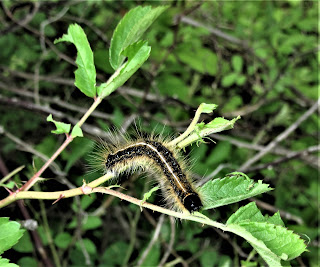Alien
Plants Benefit the Environment
 |
| A native Eastern Tent Caterpillar feeding upon an alien Multiflora Rose shrub
in Albemarle County, Virginia. |
ALL TEXT AND PHOTOS © Marlene A. Condon
Originally published in The News-Virginian (Waynesboro, Virginia daily newspaper) on October 27, 2022
On June 8, 2011, the journal Nature
published a commentary by 19 ecologists who urged conservationists to “assess
organisms on environmental impact rather than on whether they are natives”.
https://www.nature.com/articles/474153a
“Classifying biota [the
plants and animals of a region] according to their adherence to cultural
standards of belonging, citizenship, fair play and morality does not advance
our understanding of ecology [the relations of organisms to one another and to
their physical surroundings]. Over the past few decades, this perspective has
led many conservation and restoration efforts down paths that make little
ecological or economic sense”.
This other side to the story
regarding alien species—in particular, nonnative “invasive” plants—is rarely
publicized, yet it needs to be. It’s been eleven years since this essay appeared
and was ignored by virtually everyone. As a result, the general public, government
at every level, scientists, the media, and especially environmental groups and
the people that support them have now instituted a scorched-earth policy that’s
bringing about much destruction of viable habitat and the poisoning of our environment
via herbicides.
Many people fervently believe
that so-called invasive alien plants pose a dire threat to native insects,
undoubtedly due to the 2007 book, Bringing Nature Home, by entomologist
Doug Tallamy. In it, he wrote that “scientists who know what they are talking
about” developed “an extensive body of theory” that predicts that native
plant-eating insects “should be able to eat only vegetation from plants with
which they share an evolutionary history”.
This assertion, which holds
that herbivorous insects eat only those plants they have co-evolved with under
the same environmental circumstances, sounds logical to the uninitiated.
However, it disintegrates under scrutiny.
Dr. Tallamy tells us that these
6-legged critters that feed upon plant tissues are limited to feeding upon “no
more than a few plant lineages [a single line of genetic descent through time]”,
thus making them “specialists”. However, each plant lineage can include hundreds,
if not thousands, of species around the world—which means an
insect is likely to be able to feed upon at least some of the plants that are
related genetically, regardless of their country (geopolitical boundary) of
origin.
In other words, specialist insects
aren’t usually limited to just one plant species, contrary to what this University
of Delaware professor would have his readers believe. Because we know that
countries share plant lineages (and even some species), phytophagous
(herbivorous) insects should be able to eat vegetation from other areas on
the Earth even though they evolved in concert with only some of the plant
species in a lineage—and, indeed, they do.
In Bringing Nature Home,
Doug Tallamy recounts the plight of native Eastern Tent caterpillars (Malacosoma
americanum) that ran out of cherry leaves on a tree too small to feed them
adequately. He mentions that leaves were still available to the caterpillars in
the form of a Japanese Honeysuckle vine (Lonicera japonica) that had
climbed the little tree, but he points out that the caterpillars “had not taken
a single bite out of the alien plant…even in the face of starvation”.
This tale gives the reader
the impression that the caterpillars could have eaten the honeysuckle if only
it had been native, thereby having evolved with the insect. He does not
point out that the caterpillars would have faced starvation even in the
presence of a native vine, tree, or shrub if—like the alien honeysuckle—it wasn’t
a member of the Rose Family, as is this caterpillar’s preferred native host
plant, the cherry.

Several native Eastern Tent caterpillars feeding upon an alien Multiflora Rose shrub in Albemarle County, Virginia.
I have documented myself tent
caterpillars feeding on a relative of the cherry—a nonnative, unevolved with,
and much despised Multiflora Rose (Rosa multiflora) growing at the base of
a leaf-stripped Black Cherry tree (Prunus serotina). A factuality is that you can find native
insects feeding upon nonnative plants, but, of course, you need to look!
People have been manipulated
into believing alien plants serve no ecological purposes in the environment,
when, in fact, they very much do, in very many ways, for innumerable insect
(and other) species. As the 19 ecologists wrote in their paper, “[A] valuable
step would be for scientists and professionals in conservation to convey to the
public that many alien species are useful”, and that “Natural resource agencies
and organizations should base their management plans on sound empirical evidence
and not on unfounded claims of harm caused by nonnatives.”
Amen.
NATURE
ADVICE:
Don’t remove
alien plants just because they are alien plants. If you see critters
using them, ask yourself if putting in new plants will immediately provide as
much food and shelter/nesting sites as the nonnative plants presently there, or
will it take many years for the new plants to provide habitat. Plant natives
where you are increasing the amount of habitat on your property, rather
than where you are destroying it.



No comments:
Post a Comment